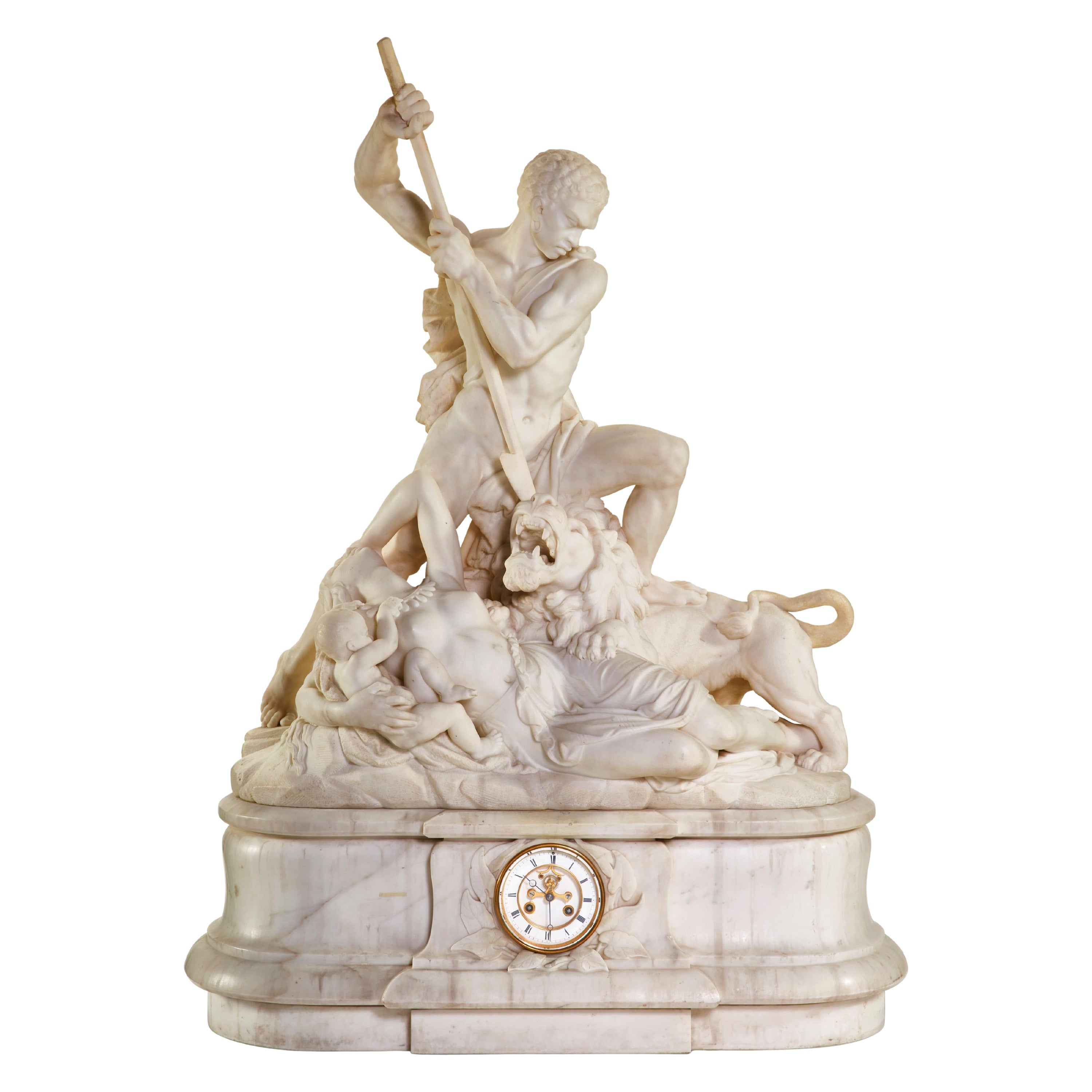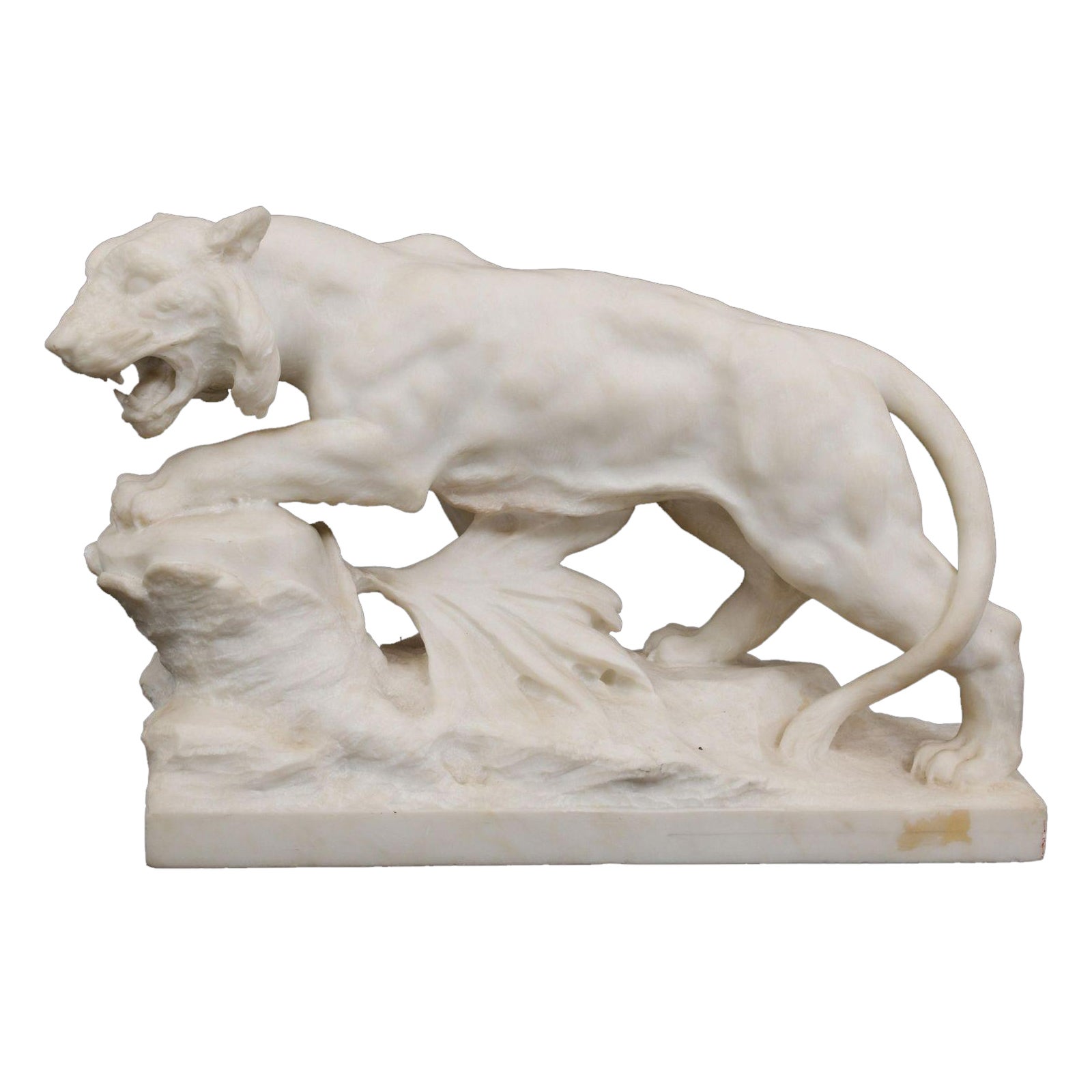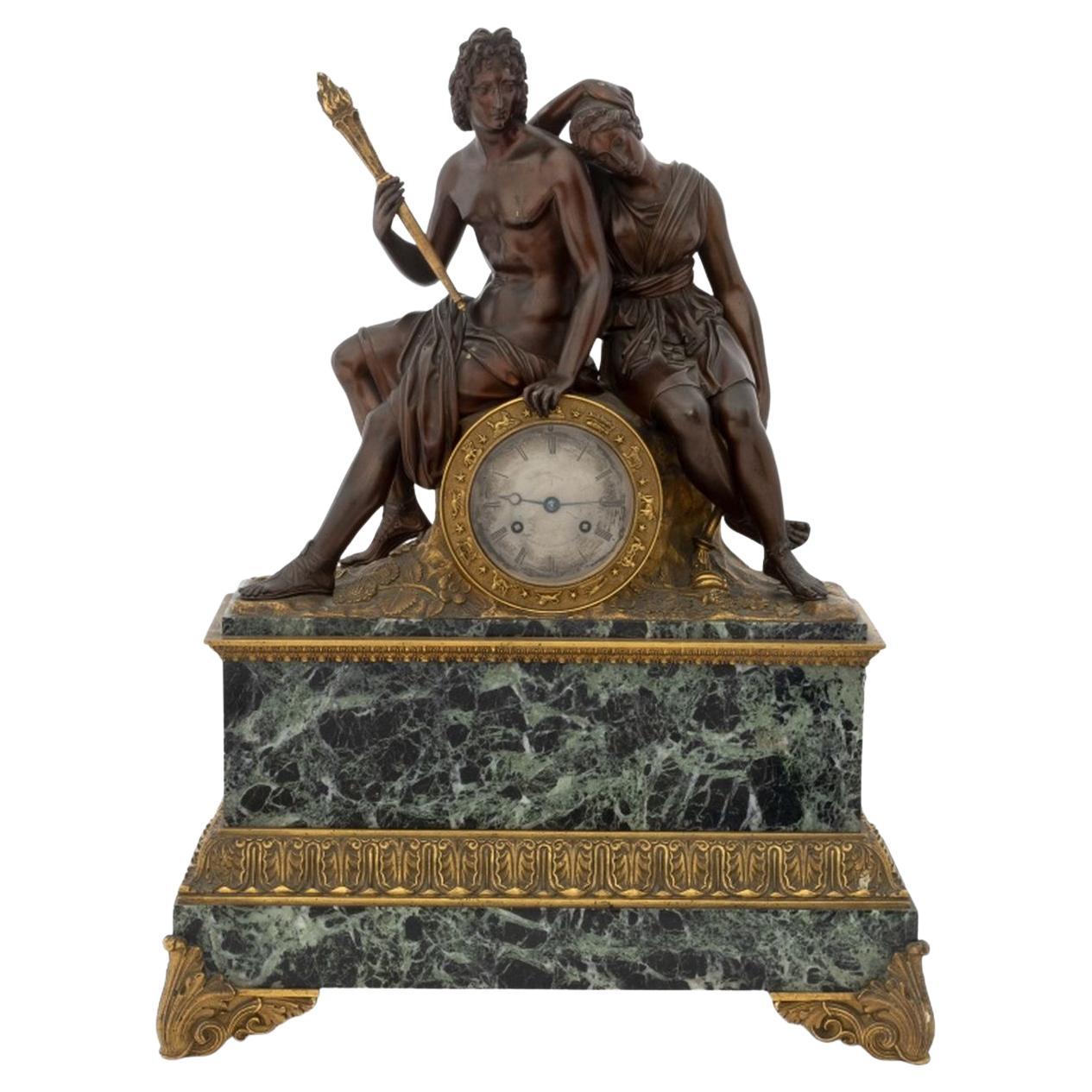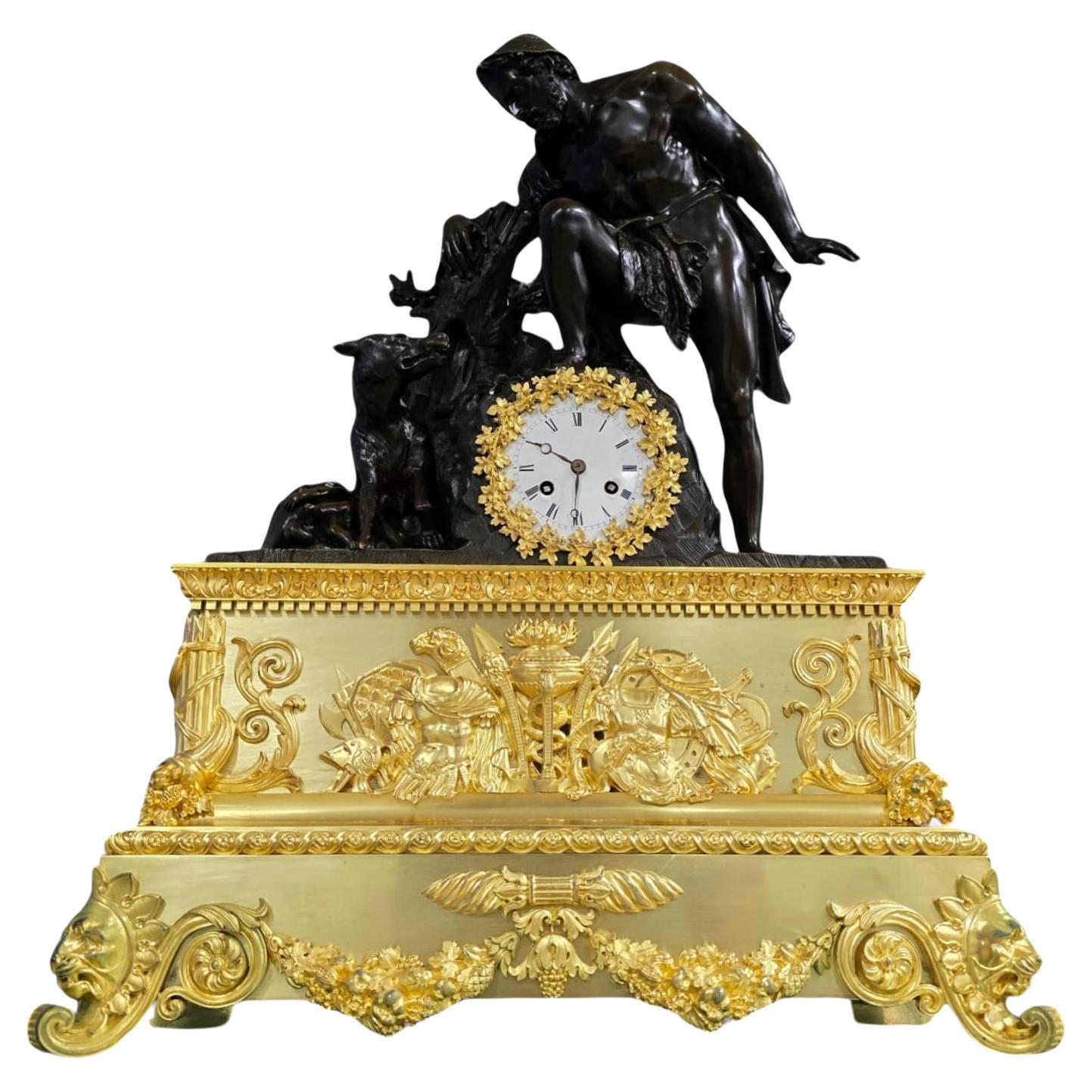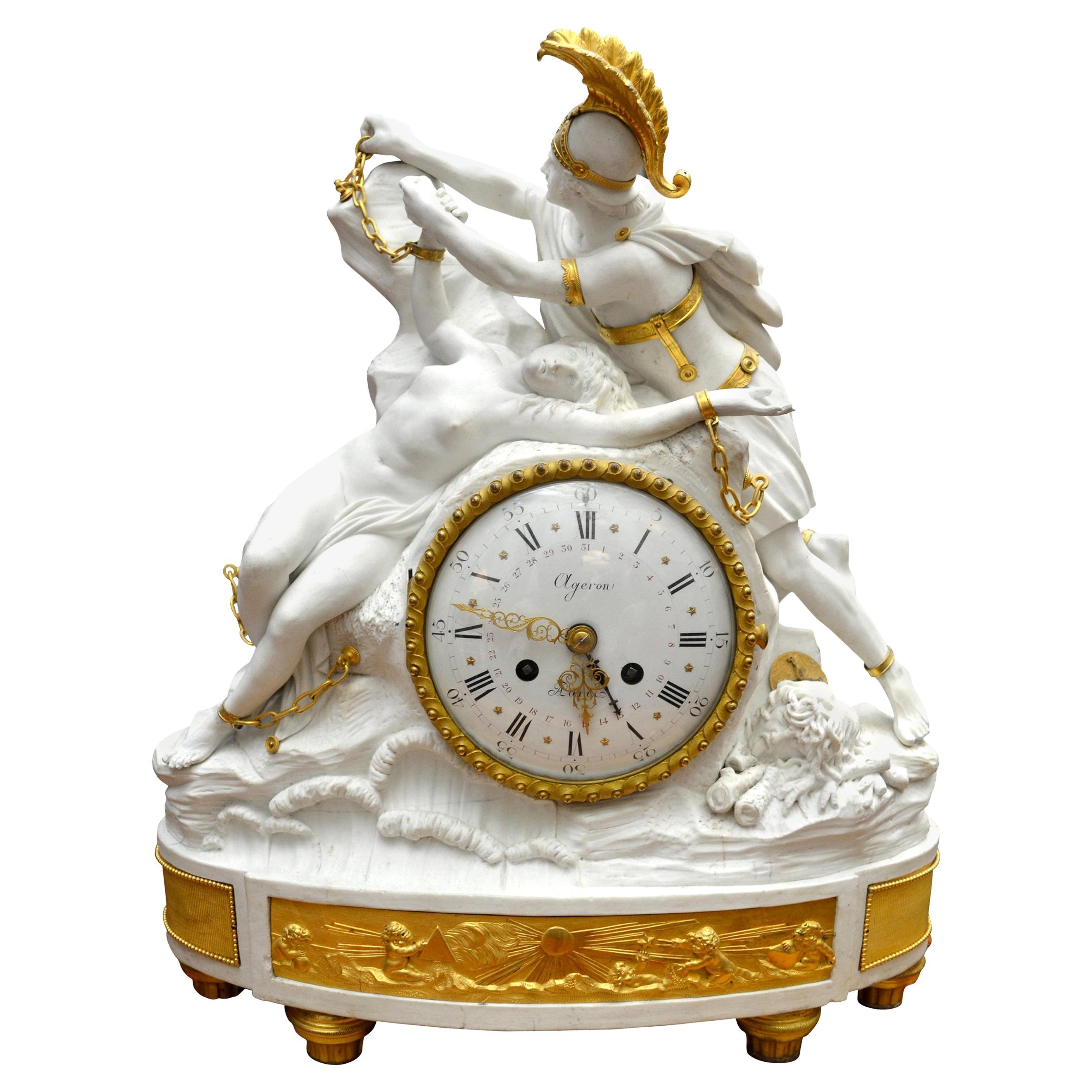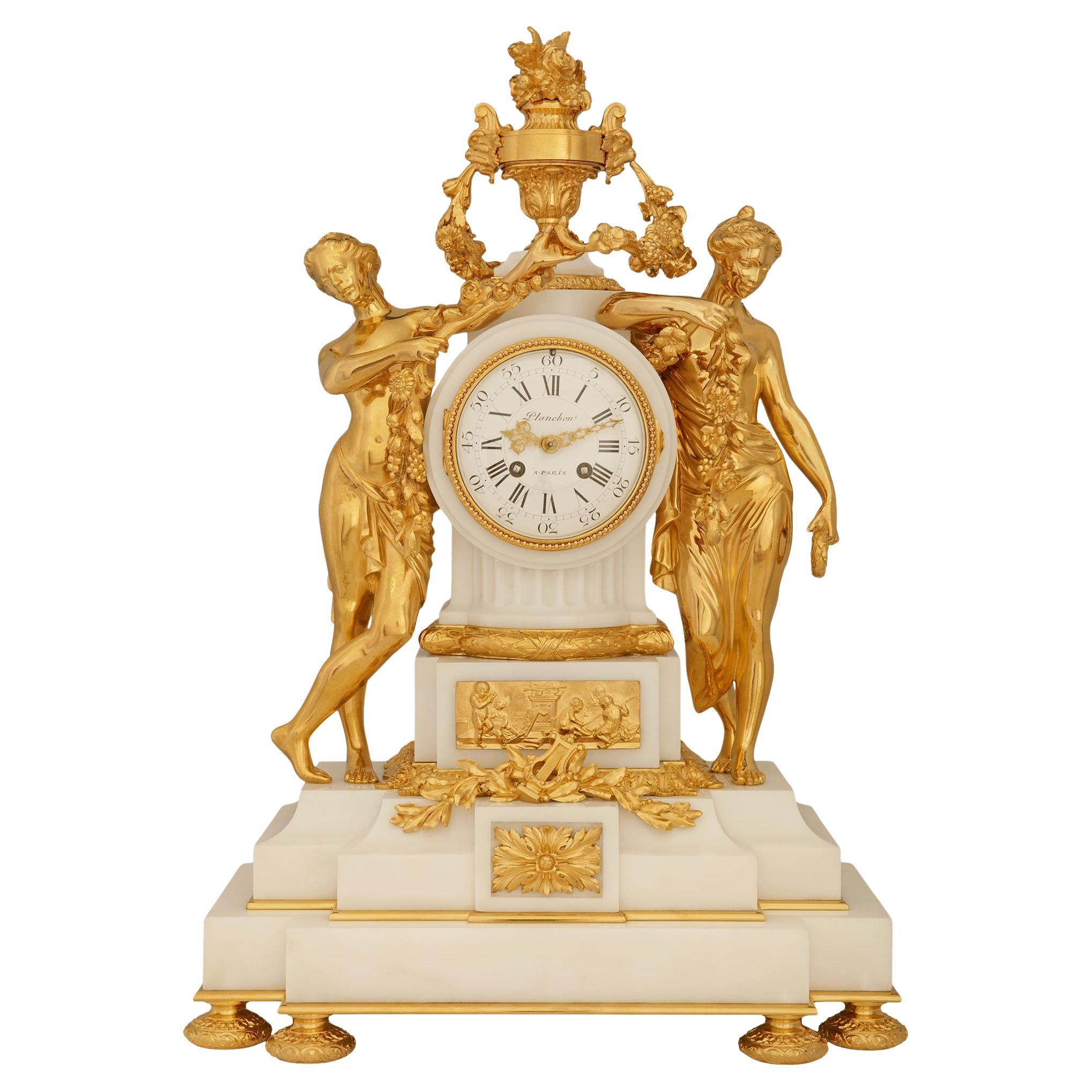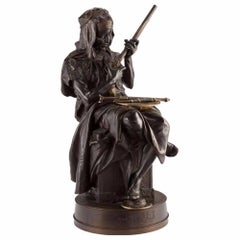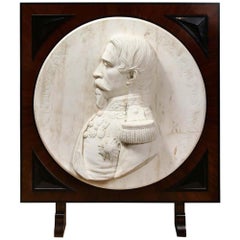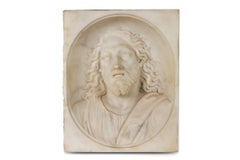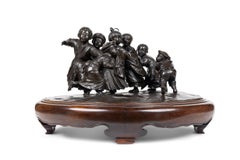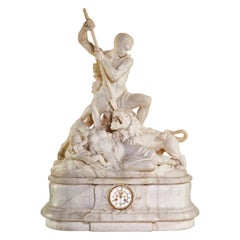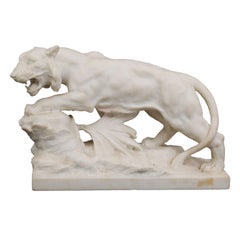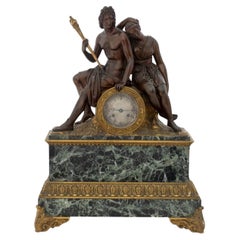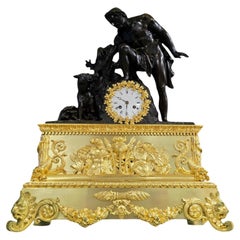Items Similar to An Exceptional White Marble Figural Sculpture Clock, "A Nubian Slaying The Lion"
Video Loading
Want more images or videos?
Request additional images or videos from the seller
1 of 14
Jean-Joseph JacquetAn Exceptional White Marble Figural Sculpture Clock, "A Nubian Slaying The Lion"C. 1860
C. 1860
$250,000
£189,564.20
€217,494.60
CA$355,719.39
A$385,875.18
CHF 202,914.72
MX$4,695,320.87
NOK 2,536,760.91
SEK 2,392,477.07
DKK 1,623,875.70
About the Item
An Exceptional and Monumental White Marble Figural Sculpture Clock, "A Nubian Slaying The Lion" by Jean-Joseph Jacquet (Belgian, 1822–1898), circa 1860
This extremely impressive white marble carved figural group depicts a Nubian defending a woman and child lying on the ground against the attack of a lion. All carved from a single slab of marble. The sculpture sits on the original white marble clock that it was made for. This was definitely a private commission piece by a Royal family in Belgium for Joseph Jacquet. Signed 'Joseph Jacquet' to left side of base.
A truly impressive and one of a kind piece.
34" high x 32" wide x 14" deep
In overall very good condition and ready to place. With normal wear consistent with age and use. Repairs to the top of his spear and to the lion's tail. The clock base with minor nicks and 'nibbling' to the lower edge. We cannot comment on the functioning of the clockworks, which should be examined by a restorer prior to use. One key, one pendulum.
Jean Joseph Jacquet, sometimes written Joseph Jacquet, (30 January 1822 - 9 June 1898) was a Belgian sculptor. He was born in Antwerp in Belgium and was the son of a baker. He studied with Guillaume Geefs at the Brussels Académie Royale des Beaux-Arts and was the friend of Peter Ludwig Kühnen (1812–1877), a painter originating from Aachen, specialised in painting romantic landscapes.
He called from Antwerp to Brussels his brother Jacques (1830 - 1898) who assisted him throughout his lifetime. Jacques actively took part in sculpture by his own productions for the Brussels art salons of 1843, 1854, 1860, 1866, 1872 and 1873.
For the 1842 Brussels Art Salon. Joseph Jaquet exhibited a marble bust, three plaster busts, a Moses Saved from the Waters and a Meditating Saint Paul which brought him notoriety.
His contribution for the 1845 Salon was more important and especially a model for a bronze statue of Froissart for Chimay but he acquired a definitive notoriety in 1854 with The Golden Age.
In 1864, he secured his first commission in Amsterdam: The Victory for the Paleis voor Volksvlijt, then a second commission for the decoration of the national monument in The Hague Willemspark.
The equestrian statue of Baldwin I of Constantinople was created in 1868 in Mons, then the pediment and lions on the Brussels Stock Exchange in 1872.
In 1879, Joseph Jaquet designed a statue of Louise of Orléans, first Queen of the Belgians: this statue was on the Place d'Armes in Philippeville then was moved to the old École moyenne, Namur street.
He was a professor at the Brussels Académie Royale des Beaux-Arts and a master of Charles Samuel.
He died in 1898 in Schaerbeek in the Brussels-Capital Region.
- Creator:Jean-Joseph Jacquet (1822 - 1898, Belgian)
- Creation Year:C. 1860
- Dimensions:Height: 34 in (86.36 cm)Width: 32 in (81.28 cm)Depth: 13 in (33.02 cm)
- Medium:
- Period:
- Condition:
- Gallery Location:Queens, NY
- Reference Number:1stDibs: LU1151211319122
About the Seller
5.0
Platinum Seller
Premium sellers with a 4.7+ rating and 24-hour response times
Established in 1980
1stDibs seller since 2019
15 sales on 1stDibs
- ShippingRetrieving quote...Shipping from: Queens, NY
- Return Policy
Authenticity Guarantee
In the unlikely event there’s an issue with an item’s authenticity, contact us within 1 year for a full refund. DetailsMoney-Back Guarantee
If your item is not as described, is damaged in transit, or does not arrive, contact us within 7 days for a full refund. Details24-Hour Cancellation
You have a 24-hour grace period in which to reconsider your purchase, with no questions asked.Vetted Professional Sellers
Our world-class sellers must adhere to strict standards for service and quality, maintaining the integrity of our listings.Price-Match Guarantee
If you find that a seller listed the same item for a lower price elsewhere, we’ll match it.Trusted Global Delivery
Our best-in-class carrier network provides specialized shipping options worldwide, including custom delivery.More From This Seller
View AllEmile-Edmond Peynot "Albaya' El Tunsi" The Tunisian Merchant Bronze, 1883
Located in Queens, NY
Émile-Edmond Peynot, (French, 1850 -1932)
An exceptional, exquisite and rare orientalist bronze sculpture titled Albaya' El Tunsi / The Tunisian Merchant / The Arab rifleman.
Dep...
Category
19th Century Figurative Sculptures
Materials
Bronze
Museum Quality French White Marble Roundel Relief of Emperor Napoleon III, 1860
Located in Queens, NY
A Museum Quality French White Marble Roundel Relief of Emperor Napoleon III, circa 1860.
The quality of this marble sculpture of Napoleon III is trul...
Category
19th Century Figurative Sculptures
Materials
Marble
Rare and Important Italian White Marble Bust Sculpture of Jesus Christ, C. 1850
Located in Queens, NY
Rare and Important Italian White Marble Bust Sculpture of Jesus Christ, C. 1850
A truly exceptionally carved marble relief of Holy Jesus Christ. Ver...
Category
19th Century Renaissance Figurative Sculptures
Materials
Marble
A Large and Exceptional Japanese Meiji Period Tokyo School Bronze Sculpture
Located in Queens, NY
Presenting an extraordinary Large and Exceptional Japanese Meiji Period Tokyo School Bronze Sculpture depicting a delightful ensemble of six energe...
Category
19th Century Figurative Sculptures
Materials
Bronze
A Rare and Important American Marble Sculpture of Thomas Jefferson, Circa 1870
Located in Queens, NY
A Rare and Important American White Marble Sculpture of Thomas Jefferson Holding The Declaration of Independence. Circa 1870, in the Manner of Horatio Stone (1808 –1875).
Inscribed on scroll: 'The Declaration of Independence, It becomes necessary for one people to dissolve the political bands which have connected them with another. etc. etc. T. Jefferson.
The present work is unsigned but is reminiscent of Horatio Stone's life-size marble figure of John Hancock...
Category
19th Century Figurative Sculptures
Materials
Marble
Rare Patinated Bronze Sculpture of Benjamin Franklin, by A. Carrier-Belleuse
By Albert-Ernest Carrier-Belleuse
Located in Queens, NY
Albert-Ernest Carrier-Belleuse (France, 1824-1887)
A rare seated bronze statue of Benjamin Franklin holding his walking stick and hat, with a book in his ri...
Category
19th Century Academic Figurative Sculptures
Materials
Bronze
You May Also Like
Exceptional White Marble Figural Sculpture Clock, "Nubian Slaying the Lion"
Located in Queens, NY
An exceptional and monumental white marble figural sculpture clock, "A Nubian Slaying The Lion" by Jean-Joseph Jacquet (Belgian, 1822–1898), c...
Category
Antique 19th Century Belgian Figurative Sculptures
Materials
Marble
Joseph Frugoni Italian Marble Sculpture of Stalking Lion
Located in New York, NY
Italian marble sculpture of a lion on the hunt by Joseph Frugoni (1897-1923). In very good condition.
Category
Early 20th Century Italian Animal Sculptures
Materials
Marble
French Empire Bronze Marble Figural Clock, c. 1830
Located in Astoria, NY
French Empire Patinated and Gilt Bronze Verde Antico Marble Figural Clock, circa 1830, the clock surmounted with seated figures of Apollo and Diana, each holding a torch, the clock w...
Category
Antique 1830s French Empire Mantel Clocks
Materials
Marble, Bronze
Large Model Empire Clock Depicting Faustulus Discovering Romulus and Remus
Located in Madrid, ES
This exceptional French Empire/Charles X mantle clock, crafted circa 1825, stands as a testament to the highest standards of bronze casting, cha...
Category
Antique 1820s Table Clocks and Desk Clocks
Materials
Bronze
Bisquit Porcelain and Gilt Bronze Figural Clock of Perseus Freeing Andromeda
By Francois Ageron
Located in Vancouver, British Columbia
A fine and rare Bisquit porcelain and gilt bronze Louis XV figural clock f depicting a famous scene in Greek Mythology of Perseus freeing Andromeda. The clock case is made of Bisquit (unglazed) porcelain. The figural group is presented on a rocky outcrop with waves lapping at their feet. She is shown lying over the clock dial with one leg and one arm chained to a rock behind her. Perseus leans agains the other side of the dial reaching to untie Andromeda from the rock behind her. Medusa's severed head is shown at his feet. The base is decorated with a gilt bronze frieze across the front showing cupids playing with stars and sun rays. The rounded sides of the clock are also decorated with gilded panels. The case sits on six toupie feet. The 6.5" white enamel dial is signed Ageron at the top and Paris at the bottom. The dial has Roman numerals with enamelled stars between the numerals; the hands are pierced and gilded. There is also a subsidiary steel hand pointing to the days of the month. The silk string suspension system has been replaced with a steel suspension system. The clock rings the hours and halfs on a bell.
The movement for this magnificent clock was made by François Ageron (d. after 1783), who was one of the leading 18th century Parisian clockmakers. Ageron’s establishment was famous and known for his horological genius he created both clocks and watches, many of which had complicated movements. He was born at Arbigny and was received as a Parisian maître-horloger in 1741, at which date he was established at Place du Pont Saint-Michel.
By 1747 he had moved to Quai des Augustins, five years later he was at rue Saint-Louis au Palais and then in 1763 at place Dauphine. Like other great clockmakers of the period he used cases by the finest bronziers notably Philippe and Jacques Caffiéri, Jean-Joseph de Saint-Germain, Robert and Jean-Baptiste Osmond, Jacques Dumont...
Category
Antique Late 18th Century French Louis XV Mantel Clocks
Materials
Bronze
A French 19th century Carrara marble and Ormolu clock, by Mathieu Planchon
By Mathieu Planchon
Located in West Palm Beach, FL
A most delightful and high quality French 19th century Louis XVI st. white Carrara marble and Ormolu clock, signed by Mathieu Planchon. This stunning clock is raised by six finely ch...
Category
Antique 19th Century French Louis XVI Table Clocks and Desk Clocks
Materials
Carrara Marble, Ormolu
More Ways To Browse
Antique Figure Sculpture
White Marble Sculptures
Antique Lion Sculpture
Marble Figural Sculpture
Marble Lion
Marble Lions
Antique Plaster Bust
Marble Statue Of A Woman
Lion Marble Sculpture
Carved Marble Figure Of Child
Lion Clock
Plaster Bust Of A Child
White Lion Sculpture
Moses Bust
Lovers Embrace Bronze
Modigliani Tete
Outdoor Pop Art
Picasso Ceramic Goat
